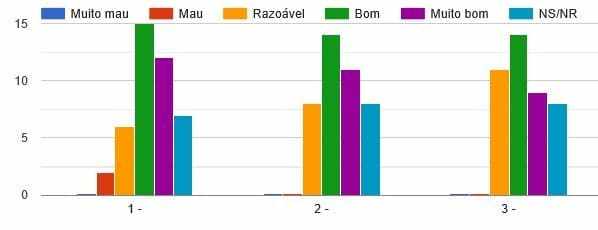ORIGINAL ARTICLE
RODRIGUES, José Carlos Meneses [1], BARROS, Ana Beatriz Freitas [2], ALVES, Ana Rita Carminho [3], RIBEIRO, Carla Isabel Mendes [4], SANTOS, Filipa Andreia Mendes [5], COSTA, Joana Alves da [6], SILVA, Sara Catarina Ferreira da [7]
RODRIGUES, José Carlos Meneses. Education by art: Self-education in preschool and the 1st cycle of basic education. Revista Científica Multidisciplinar Núcleo do Conhecimento. Year 05, Ed. 08, Vol. 03, pp. 112-150. August 2020. ISSN: 2448-0959, Access link: https://www.nucleodoconhecimento.com.br/education/education-by-art, DOI: 10.32749/nucleodoconhecimento.com.br/education/education-by-art
ABSTRACT
The study emerged in the context of the curricular unit of Education by Art inserted in the Master’s degree in Preschool and 1st BEC (Basic Education Cycle), with the sharing of students. The activities provided in the Preschool and the 1st BEC contribute to the formation of children in the construction of their own knowledge and knowledge, stimulating curiosity, imagination and creativity; hence the role played by Education by Art, an ideal vehicle for the autonomy and self-education of children and students. We highlight two objectives of the study: to associate it with the promotion of self-education and to justify the dimension of Art therapy in school and non-school contexts. We were able to obtain a qualitative and quantitative methodology through a sample of 151 teachers and students from the higher education institution to which we belong. Fifty-six individuals (37% of the sample) answered the survey, via Google Forms, a utilitarian model, but with some constraints in reading some dimensions. We have recorded some considerable results: Artistic Education still has a strong impact on the educational system; Art Education conquers space in a journey where interdisciplinarity, multidisciplinarity and transdisciplinarity constitute an irreversible path; Art therapy obtains a high appreciation from respondents, deserving of an in-depth study. POASR (Portugal Open Access Scientific Repositories) and Google Scholar were the capital platforms for the solidification of the theoretical foundation. We consider a fundamental conclusion: the artistic dimensions will be more visible with a basic positional reinforcement (educators, teachers and groupings) through a solid collaboration in the Arts/Expressions in order to reach a high level in Education for Art, moment, among others, in which the child will feel the benefits of self-education.
Keywords: Education by Art, Artistic Education, Art Therapy, Preschool, 1st Cycle of Basic Education.
1. INTRODUCTION
The theme is justified in giving voice to the arts – namely Education by Art – facilitating the task of educators, teachers, students and parents. The autonomy of children is a crucial step for their future and society in activities that stimulate and arouse curiosity and the desire to acquire new knowledge.
To this end, the arts and contributions of the Expressions/Arts in the Curricular Guidelines of Pre-School Education (OCEPE) and the 1st CEB programme are covered; we include Art therapy as a fundamental element in the process of autonomy, with simple instruments available to educators, without removing the role that the specialist develops in cases of a specific nature. Art therapy/psychotherapy professionals intensify the aesthetic debate with the objective of significant experience by the contributions of creativity brought to light from the benefits produced in the sessions (CARVALHO, 2018).
We delimited the study to the context of the Art Education curricular unit inserted in the Master’s degree in PE Education and 1st CEB, with the sharing of students, without looking into the context that other terminologies (Artistic Education, for example) do not obliterate the objectives of the former; we consider the existing difficulties with the concepts of interdisciplinarity, primarily due to the current resistance that constantly leads to reconsidering our attitude and objectives in the field of the arts in the education of educators/teachers.
Therefore, we do not omit sensitive issues in the Preschool and the 1st CEB: unprepared teachers and teachers without motivation for the area in question; prioritizing results over quality; and the scarcity of teaching and auxiliary staff. These are constraints that guide us to a question: What is the role of Education by Art for the evolution of the PE and the 1st CEB?
We stipulated objectives for the study: a) to associate Education by Art with the promotion of self-education; b) to evaluate the promotion of arts in teaching, including interdisciplinarity, multidisciplinarity and transdisciplinarity and the realization of events; c) justify the dimension of Art therapy in school and non-school contexts; d) understand school performance with performance in artistic activities in non-school context and in children with special needs.
We use the Artistic Expressions of the master’s study plan and, as a priority, the need to reorient the interests of children and students in favor of activities that provide autonomy that compromises a desired self-education. The goal is to get out of traditional corsets, offering educators and teachers situations of true learning, starting, for example, from the analysis of an artistic work (line, circle, color…) and developing free activities so that each interpreter is valued and valued for what he does. The arts traditionally turn to the teaching of techniques and aesthetic-scientific principles; they are congruent in people with artistic training in a given art and intend the spiritual elevation of the child towards Belo and Bem (SOUSA, 2003). Expressions/Arts trigger in the child his interests for the performance of any task, causing his attention and determination to increase; “[…] they build their own texts and images and become aware of themselves as authors and image builders” (HOHMANN and WEIKART, 1997 apud CANELAS, 2015, p.14).
Artistic Education became official in the 1970s (VAZ, 2015), incorporating artistic activities into school education in a less honorable way; one consequence was the training of multipurpose teachers, professionals in fine arts, music and performing arts in a short course (two years) that, in the classroom, presented decontextualized techniques.
In the middle of World War II, the philosopher Herbert Read launched the work Education through Art (1943) which involves art as an integral part of the educational process itself that advocates a new approach in the transmission of knowledge, considering the expressive, creative, artistic and aesthetic activities implicit in the integral and humanist formation of children and adolescents. The principle emerged, but acceptance, as a novelty, is always time consuming, besides, the author, continuing the path of anarchism – coertion that did not let revenge in the educational environment – and living in a period of belligerence (KEEL, 1969).
However, UNESCO, with the concern of bringing the concepts of Education through Art and Artistic Education closer together, recalls the right to education and culture by giving voice to a concept that we intend to explore in education (CASALS, 2012), in a collaborative process because we reinvent ourselves and every day we return to the different places where we live, producing culture with the people with whom we interact. This is the inexorable process of humanization where children take their first steps in school, remarkable for their whole life, in a positive plan if those steps are solidified by the winds of a pedagogy open to self-education. And art is an immeasurable field for the defendant (FILHO; BULCÃO; BATISTA, 2019).
But we cannot neglect the fact that, for a long time, we teach art for the sake of art, appreciation and interpretation of objects of art, cultural objects and techniques of artistic expression and communication, integrating contents on heritage education, namely tangible and intangible heritage for an understanding of cultural diversity. Given this scenario, it is necessary to reformulate a pedagogy for the arts, closer to the processes that contemporary artists are using in a social context. They are fundamental collaborative spaces for educators and teachers in an artistic approach conducive to education by art, leivas that can soon emerge due to an imperative paradigmatic change (EÇA, 2016).
We do not dissociate Arttherapy from our study (in its simplest devices), characterized by Carvalho (2011 apud RIBEIRO, 2012) as a method of psychological treatment, incorporating artistic mediators into the psychotherapeutic context. It is usually very well received in schools (in the few examples where it is used), with the use of the most varied techniques: plastic expression, musical, dramatic, corporal. Its use in a non-school context – hospitalization, mainly – is essential for a faster recovery, with interdisciplinarity, an indispensable link in the educational process.
We reiterate one of the conclusions of the study: the artistic dimensions will be more visible with a basic positional reinforcement (educators, teachers and school groups) through a solid interdisciplinary collaboration in the Arts/Expressions in order to reach the level of Education by Art, moment, among others, in which the child can feel the benefits of self-education. The study flows with the following topics: fragments of art through education; from concepts to case studies; methodology; results, analysis and discussion; and final considerations.
2. FRAGMENTS OF ART IN EDUCATION
Almeida Garrett (1799-1854) included the Arts in an aesthetic formation, founding, in 1836, the National Conservatory (schools of Dramatic, Music and Dance), prevailing the formation of artists. At the end of the 19th century, the pedagogue Adolfo Coelho enshrines artistic education as a basic element in the formation of man (CÂMARA, 2007).
The 1st Republic (1910-1926) – a lost hope – integrates the arts in the educational system with a campaign for Artistic Education led by João de Barros, poet and pedagogue, with the principle that there is no democratic society that can live without the cult of art, that is, without artistic education there is no education of sensitivity (CÂMARA, 2007).
Almeida Garrett, Adolfo Coelho and João de Barros are contributors to artistic education in times when illiteracy was 80% (1st Republic).
Herbert Read[1], in his publication Education through Art (1943), conveys a simple and incisive concept: “[…] art must be the basis of education”. Other authors follow Read agreeing, disagreeing or adding elements to their concepts. We accept, like Keel (1969) the understanding of artistic expression as development of learning, using creativity, freedom of expression, the pleasure of experiencing alternative paths. Educating by art also allows the unwinding of critical sense, imagination, memory, logic, power of analysis, synthesis and reflection. The different forms of expression – music, images, theater, dance, painting or drawing – allow an ambience full of learning opportunities. In addition to self-education, the child develops with the world and with respect for diversity.
They are capital concepts, but difficult to materialize by the pressures of the time, of an economic and social order, but mainly of mentality.
2.1 PORTUGUESE ASSOCIATION OF ART EDUCATION
Herbert Read’s work has reflections in Portugal, with the creation of the Associação Portuguesa de Educação pela Arte (1956) – chaired by Professor Alice Gomes -, and with pedopsychiatrists such as João dos Santos and Arquimedes da Silva Santos, painters such as Almada Negreiros and Nikias Skapinakis, musicologists such as João de Freitas Branco and Calvet de Magalhães, one of the main promoters of the Association (SANTOS , 2013).
We note some guidelines of the movement: i) Education by Art is not primarily aimed at the formation of artists (although it can do so), nor the formation of new audiences (despite having this effect), nor the facilitation of other so-called more academic learning (notwithstanding the fact that it does, certainly). But what really aims is to contribute to the more global development of the personality of every human being; ii) Education by Art implies an active pedagogy, seeks to promote the creativity of children and young people, fostering their expressiveness and leaving it for an aesthetic education and other educational situations; iii) Education by Art takes into account the affective, emotional development that has greatly interested pedopsychiatrists such as João dos Santos and Arquimedes (SANTOS, 2013).
2.2 CALVET DE MAGALHÃES AND THE FRANCISCO DE ARRUDA SCHOOL (LISBON)
At the entrance of the 1970s, the Calouste Gulbenkian Foundation continues to play a major role in Artistic Education and Education by Art, creating in 1971 the Pilot School (later called The Higher School) of Education for Art already with forums of official acceptance.
Meanwhile, Calvet de Magalhães continues to lead the Francisco de Arruda School, transformed into a Preparatory School from 1968. As a pioneer he was, he participated in most of the pedagogical experiences then rehearsed, often being even his promoter “[…] as those of co-education, integration of students with special educational needs, the 7th and 8th experimental years and the use of audiovisual media”, making it a reference school.
Calvet de Magalhães embraced the cause of Education for Art, the artistic expression of students, art as a starting point for other learning, for individual and collective enrichment (SANTOS, 2013, p. 45-46):
He was able to make it happen in the organization of the school, from the walls covered with quotations and paintings of the students – and that none dared to spoil – of which he was well proud – to the opening of the school to parents, to the neighborhood, to the community through cultural sessions on Saturday mornings; from the clubs of interests that promoted the importance he gave to the word, to the languages, to the expression of young people and to the way he took advantage of the interests and talents of the teachers he hired.
We believe that it was an experience that did not have the basis of dissemination and, as a barrier, the non-absorption by the ministerial guardianship, whose principles of the Estado Novo were not in line with the spirit of freedom that was implicit in this pedagogy of art. Just remember that the rectors and principals were powerful figures at the school level, with effective powers with teachers and their staff. Calvet de Magalhães (tragically dying in 1974 in the workplace), ran a school in the Neighborhood of Ajuda (Lisbon), in a strange social intersection to half-walls with middle-class dwellings, high bourgeois mansions and slums, the Francisco de Arruda school “was a true miracle of pedagogical experimentalism”[2].
2.3 ARQUIMEDES DA SILVA SANTOS IN THE HIGHER SCHOOL OF EDUCATION BY ART
While in the 1970s, Choral Singing and Drawing were the artistic disciplines of school curricula (CÂMARA, 2007), the School of Education for Art remained between 1971 and 1981 at the National Conservatory, with the essential contribution of Arquimedes da Silva Santos, whose discipline of Psychopedagogy of Artistic Expression (1973-1974) presented, in the first topic, Generic Vision of Education for Art, repeating itself in 1979/1980 (MEIRA, 2015). Applicants were admitted at least 16 years of age (with the 7th year of high schools). The direction of 1971/1972 recognized that the function of the School “[…] was part of a humanistic mission of Education by Art […] in a concession of Higher School, open and free […] the only one compatible with a pedagogical action by Art”. (SANTOS, 2013 apud MEIRA, p. 2015, p. 52). In 1972/1973, in the results of surveys conducted with students, the three-year pilot project was considered favorable and it was possible, through art, “[…] to have a pedagogical intervention with children and adolescents in addition to having acquired new perspectives for it” (SANTOS, 2013, I, p. 19 apud MEIRA, 2015, p. 57-58). The professional departures were an obstacle to the success of the project, as well as the legal recognition and emerging conflicts in the post-April 25, 1974 (MEIRA, 2015). With ascending and setbacks, the School of Training of Teachers of Education by Art is confronted with a ministerial order where it is registered that, in the school year 1980/1981, registrations would not be allowed to new students (MEIRA, 2015). Despite a last attempt at reorganization in 1981, Madalena Perdigão acknowledged that the educational value of the arts was faced with the refusal to include them at the highest level of education – citing Meira (2015).
Calvet de Magalhães and Arquimedes da Silva Santos dreamed, tried and realized, but the “top” and “base” looks crossed in the same objective, which point of escape: what is new upsets habits and mentalities; developing the critical spirit and autonomy of children and young people is a feasible purpose only in small fields, whose fences do not allow the desired dissemination in the educational system.
They were pedagogical projects that could have changed our educational system, at the level of basic education, mainly. Calvet of Magalhães had a tragic end; Arquimedes da Silva Santos would lead to the expansion of Education by Art, its great guiding line, through the training of specialized professionals.
At the same time, traditionalism dominated, an imposition that was nothing more than children’s artistic experiences with the practices of Lavors, Geometric design or Free – new state syndrome rooted in mentalities that did not absorb educational concepts in line with a new era!
2.4 MISTAKE OF EDUCATION FOR ART OR THE ABSENCE OF A CONSISTENT PEDAGOGY
The failure of the Higher School of Education by Art was a proof of unprecedented interests, wandering education for art in the waves of personalities invested in decision-making positions by mandates, not continuing what was able to succeed.
Sousa (2003) states that Education by Art proposes the development of artistic expression and Education for Art aims at the formation of professional artists, being processed through artistic teaching. Two concepts are praised which, over time, would lead to clarification; the suspension of the School of Education for Art in 1981 (MEIRA, 2015) – where Arquimedes da Silva Santos was pontificated – annulled a fundamental project of Education, a fact that demonstrates the difficulties of the imposition of Education by Art already in a period of democracy where, how many times, opportunities are lost for ideological (political) reasons.
The Basic Law of the Educational System – Dec.-Law No. 46/86, of October 14 – promotes Artistic Education (CÂMARA, 2007) (4th phase of the History of Art of our educational system – Sousa, 2003, I), which is accepted as an important factor in the integral formation of the person, in the curricula of Preschool, Basic Education, Higher Education, Extraschool Education and Special Education. Expression skills, creative imagination and playful activity are promoted; Artistic Education and the various forms of Aesthetic Expression “[…] are an important factor in the integral formation of the person, and should therefore be an integral part of the education system” (CÂMARA, 2007, p. 47).
The meaning of Education for Art that reemerges in the Dec.- Law of Artistic Education (No. 334/90, of November 2), with the diversity of the areas of Expression and Music Education, Expression and Dramatic Education, Expression and Plastic Education, Expression and Motor Education is lost. Fourteen years later, Dec.-Law 74/2004, of March 26, also considers the implementation of the System of Full-Time Schools, with enrichment activities, including those of an artistic nature (CÂMARA, 2007).
In 2003, Sousa raised the issue of the training of teachers who had the responsibility of Artistic Education, noting the recent creation [1994] of the Portuguese Movement for Artistic Intervention and Education for Art (MOVEA)[3], which favored the formation of the individual as an element of a social collective, in line with what is called Education for Art[4].
We deduce that education by art, since the 1950s. XX, circulated to the taste of ministerial decision-makers not imposing itself as a methodology to follow in a perspective of self-education, regardless of whether it was addressed in the Estado Novo or post-April 25, 1974. And if something has sprouted is the foundations that we owe, that is, the result of the work of educators and teachers who intend to exercise their mission with the conviction that our era is to focus all attention on each child and student, providing the tools of autonomy and consequent self-education – in addition, of course, the cases of Calvet de Magalhães and Arquimedes dos Santos Silva , among others.
Will we have the answer with the National Arts Plan?[5]. This is the project of the Ministries of Culture and Education for the 2019-2029 time horizon through the Council of Ministers Resolution No. 42/2019 of February 21, involving artists; educational community; cultural institutions; other government agencies; municipalities; foundations; higher education institutions; media; associations and collectivities; other public and private partners. The fundamentals are based on the autonomy and curricular flexibility that enable schools to manage their own curriculum of primary and secondary education; the arts can be incorporated into the basic curricular matrices, as well as what has been promoted by the Aesthetic and Artistic Education Program, the National Reading and Film Plans and the Networks of School and Portuguese Library Museums – united in a common strategy that is the mission of the National Plan of Arts.
We do not know progress, after more than a year, and the possibility of success of Education by Art, because there is already a Program of Aesthetic and Artistic Education …
3. FROM CONCEPTS TO CASE STUDIES
3.1 ARTISTIC EDUCATION AND EDUCATION FOR/FOR ART
We warn that the theoretical foundation is continued in 4. Results, analysis and discussion, by methodological option, making this practical step more solid. We started with Sousa (2003, I), who considers four periods in the development of the arts in Portugal: a) the Arts in Education; b) an Education including an Aesthetic Training; c) Education by Art; d) and Artistic Education. In the index (2003, I), the author draws Artistic Education, including: a) Art and Education; b) Artistic Education; c) Aesthetic Training; d) Education by Art; e) Arts in Education; f) Artistic Education.
Artistic Education (4th period) is activated as the whole in the index, with the following correspondences: Arts in Education (1st period) with Art and Education; Aesthetic Training and Education by Art are common; in the index, artistic education is added. We infer that the author emphasizes Artistic Education and Education by Art, an order that respondents confirmed in first and third places (table-graph A1).
3.2 AESTHETIC AND ARTISTIC EDUCATION: PROGRAM FOR THE 1st BEC
Sousa’s (2003) work focuses on Educação pelas Artes e Artes na Educação, in three volumes. While we intend to re-image Education by Art, we cannot learn about studies and proposals that are distinguished in terminology, but which basically intend to take on a change in the field of Arts/Expressions.
This is the case of Aesthetic and Artistic Education in the curriculum of the 1st CEB: a way of implementation, which results from the Aesthetic and Artistic Education Program for the 1st CEB and, to consolidate it, a Teacher Training Plan. Herbert Read (1943, Educação pela Arte) is not included in the bibliography of the study, by ideological and methodological option, since the authors are based on the legislative process of the Teaching of Aesthetic and Artistic Education of the 1st CEB that was legitimized by two documents – Decree-Laws No. 139/2012, of July 5, and No. 91/2013, of July 10 – prior to the legislation in force in 2017, at the time of the dissemination of the study. The second deserves more attention because it was called Artistic Expressions Learning Goals, published in 2010.
Despite the inconsequences, the authors consecrate “aesthetics and art as a fully fledged disciplinary field in the curriculum of this Cycle”, obeying defined school times, with contents and objectives/goals to be achieved in Decree-Law No. 91/2013, of July 10 (MATEUS et al., 2017).
In the bibliography dominates the legislation produced by the National Council of Education, Ministry of Education and Ministry of Education and Science, not without there being a fluidity of autonomous thinking, such as, for example, the reasons for pending ineptitude on Aesthetic and Artistic Education: i) the overvaluation of Mathematics and Portuguese; ii) pedagogical-didactic concessions that make children naturally inventive and creative, denoting initiative and autonomy, so it is not necessary to go through an organized teaching process; now, while the authors question this assumption, we put ourselves on the opposite side, because it is one of the principles of Education by Art; iii) a third reason is related to the neglect of the role of Aesthetic and Artistic Education in the cognitive development of children, to the detriment of motor and affective development (in the sense that what they perform has to have an individual meaning). Without denying these last two dimensions of development “[…] one cannot neglect the fact that research highlights the potential of aesthetic and artistic education in the structuring, from early ages, of intellectprocesses” (FROÍS; MARQUES, GONÇALVES, 2000 apud MATEUS, et al. 2017, p. 235).
The proposal of Aesthetic and Artistic Education brings the multisensory and interpretive character of the various Expressions – Dance, Music, Visual Arts and Drama/Theater. The program is presented as a means to awaken students to the great questions that aesthetics and art are occupied, leading them to observe works of art, dialogue about them and experience from them (MATEUS; DAMIÃO; FESTAS, 2014, apud MATEUS, et al. 2017).
We agree with this path, because it is one of the principles of Education for Art, particularly in the PE, when one dialogues about an abstract work by Miró, for example, and children are asked to observe lines and, from them, elaborate their work (drawing, collages…): students observe works of art enjoying the diversity of stimuli, oriented in the argumentative dialogue about the meaning or meanings that propagate their meanings that propagate , with emphasis on what each assigns – being also invited to explore ideas and manipulate diverse materials in order to produce something (MATEUS; DAMIÃO; FESTAS, 2014 apud MATEUS, et al. 2017).
The authors record the formation of a team of specialists – Aesthetic and Artistic Education Team – based on internationally recognized programs, which conceived the so-called Aesthetic and Artistic Education Program in the School Context; its implementation in the 1st CEB, which was optional by the school and always done through non-specialist teachers, covered about eighty school groups throughout the country. We did not know the results, because the intention of the team was to evaluate its impact in terms of learning after 2017, when the study was released.
We can see that Aesthetic and Artistic Education does not differ substantially from Education by Art, a fact that we are pleased to record, because, by apparently different paths, we have reached the objective: to provide children with a path of self-education through art.
3.3 THE SUSTAINABILITY OF EDUCATION THROUGH ART
Education through art for a sustainable future is a study that brings together the educational and social fields. Teresa Torres Pereira de Eça (2010) – without resorting to Read (1943) -, employs the keywords: artistic education; art and education; creativity; citizenship education; sustainable development, which support our research.
Art and education through art are fields that interpenetrate. There are contemporary artists, educators and teachers who work on innominated social projects integrating at-risk and special children and adults, prisoners and sick; they are artists who work in social causes, escaping them, as an objective, the elitist art market, “[…] resuming the role of the shaman artist, providing experiences of knowledge of ones and the world through art” (EÇA, 2010, p. 3). Likewise, there are art teachers who escape the conservative methodologies of schools, helping students with transversal experiences of learning with art and art, without the intention of forming artists or audiences, reaching a sustainable future, where individuals are, first of all, more creative, more critical and more supportive.
The economic weight of culture and creative industries for which the British government’s performance in 2010 was exemplary, implementing a curriculum, where creativity and transdisciplinarity were the essential axes and art and artistic education had a space to strengthen. These changes have very large implications in the definition of artistic education, because, by nature, teaching through art and cultures can include transdisciplinary axes, breaking down barriers without losing their specificity. Art leads to the promotion of a wide range of creative qualities and critical capacities, and can be the center of the curriculum, provided that artistic educators reorganize their practices in order to benefit these objectives (EÇA, 2010).
The European Year of Creativity and Innovation in 2008, following and continuing the European Year of Intercultural Dialogue in the same year, are events that interchange creativity that is rarely at the top of school priorities, since most of them dominate a certain degree of conformism, where the game does not enter; the school is made of “seriousness”, with rigid schedules and deadlines for the delivery of works that does not foster the desire to explore, not accepting, therefore, nonconformist and audacious behaviors (STEERS, 2008 apud EÇA, 2010, p. 3) .
We coincide with Eça (2010), in its cross-sectional and longitudinal approach, where education through art underlies the construction of a sustainable future, because they promote creativity, innovation and critical thinking, that is, the fundamental capacities for a liberating culture, equality and social responsibility.
Education through art, when it focuses on citizenship and values, can transform the curriculum and recreate the school through transdisciplinary projects, breaking the barriers between areas of knowledge, there is a need to review and reformulate the current paradigms of education and approaches through art and, above all, establish strongly in the training of educators and teachers (EÇA , 2010).
Artistic education and the promotion of creativity and innovation are based in studies where students who have followed a path with a good-level art education in any area (musical, visual, drama, dance), have developed interpersonal and intrapersonal abilities, being more tolerant, managing to “[…] use divergent and convergent thinking, are more curious, more open to change, are not afraid to risk and are more critical than students who have not had access to artistic education programs” (EÇA , 2010, p. 5). Moreover, based on studies, the author points out that a quality artistic education will provide vision and vision skills, perseverance, more playful abilities, more propensity to learn through mistakes, more critical and more able to justify their opinions.
Eça (2010) questioned the promotion of a sustainable future through the performance of education by art. Alfredo Palácios and Javier Abad Molina developed in Spain a work in which there are no boundaries between the teacher, the researcher and the artist in the critical dialogues triggered in the communities where the projects emerged, “[…] from words and images […] (GARRIDO and MOLINA, 2008 apud EÇA, 2010, p. 5)”. Paulo D’Alva did social work in a Gypsy community in Santa Maria da Feira (northern Portugal) through an animation cinema studio (CARRO BRANCO CARRO PRETO apud EÇA, 2010). A Brazilian art educator – Lila Rosa Ferro -, collaborated in the project “Awapa: nosso canto”, from a network of partnerships in order to preserve the Yaqwalapíti culture, in the upper Xingu, through the preservation of popular music. In the book that Ferro (2008 apud EÇA, 2010) organized for the Yawalapíti community, Aritana’s speech summarizes a capital reason that artistic education should have in education: the passage for younger people.
3.4 CLIO[6] IN SCHOOL WITH ART AND CREATIVITY
Bahia (2010) ensures art, creativity, culture, artistic education and memory as key words of its study. Approaching education for art (without implicating Herbert Read in bibliography) and for culture, we engage in the disciplinary knowledge of Art History and Creativity that also seek to foster in theory or practice an education for Art and Culture.
In an open ambience, conventional questions dematerialize with the use of flexibility, intuition, spontaneity and imagination; by pursuing the passionate search for knowledge of the outside and inthe world, they enable others to transform and, at the same time, bring down the myths that start creative development and sensitization directed to the critical and aesthetic appreciation of the world (BAHIA, 2010).
In a convenience sample of 40 teachers all argued that art history was fundamental to students. Being 36 years the average age in a group of 25 men and 15 women, 23 humanities and 17 arts, 21 teachers relocated knowledge, 8 creativity and 11 knowledge and creativity; but capital is the fact that 80% of teachers associate the teaching of art history with knowledge and only 47.5% register creativity as the foundation base (BAHIA, 2010). This conclusion explains the distance between elitist teaching and what should develop children’s growth in favor of autonomy, that is, the critical spirit so necessary for self-education.
Mythology is a resource for Bahia (2010) – a clio that inspires; thus, imbued with the spirit of creativity and knowledge of art, the professor of Art History or any other discipline conforms to his students pleasure of noble knowledge and continue to look at everything that surrounds them with curiosity and interest.
Regardless of the terminology used – Education by/for art, Artistic Education – this fact proves the difficulties that educators and teachers of the 1st CEB can demonstrate; the evidence is the misdeed with creativity! Thus, we point out our agreement with the author regarding the change of attitude of an education by/for art or artistic education.
4. METHODOLOGY
The research was framed in the curricular unit of Education by art of the Master’s degree in Preschool and 1st CEB, in the Higher School of Education in which we teach, with the participation of students.
We use the qualitative and quantitative method; due to the rigorous and meticulous nature of the former, a thorough review of the literature and the elaboration of a balanced research plan outlined in the objectives and structuring is required. The qualitative methodological nature is opposed to numerical representation, statistical analysis, positivist, confirmatory and experimental approach offered by qualitative methods. The quantitative model uses numerical measures in a rigorous collection of data that, at a later stage, are submitted to statistical analysis through mathematical paradigms, or appropriate software (FREITAS, 2005).
The methodology focused on the documental analysis of the digital bibliography of the Scientific Repositories of Open Access of Portugal (RCAAP) and Google Scholar and also in physical bibliography. With a universe of 316 elements (students and teachers of the ESE where the study took place) we selected a sample of 151 teachers and students of Basic Education, Masters and Specializations in Education. An eight-element pre-test was carried out so that we could reorganise questions that raised doubts. Fifty-six individuals (37% of the sample) answered the questionnaire survey, via Google Forms, with limitations related to the degree of depth of the information collected. The analysis of the results did not include the codification of responses; the clearance, treatment of information and preparation of the fundamental conclusions were based on 4.1 Results, analysis and discussion.
The case study is Education for Art in the Preschool and the 1st CEB, a concern common to countless teachers who understand that children, educators and teachers would achieve immeasurable levels of learning if it were implemented with the guarantee of promoting their self-education. We said that expressions/arts would already be crucial to this effect, aiming at the highest level: Education for Art. The educational order of self-esteem and self-education grow exponentially with the valid instruments that children assimilate in the Preschool and the 1st CEB, foundations and pillars of a liberating education.
4.1 RESULTS, ANALYSIS AND DISCUSSION
4.1.1 ARTS IN TEACHING
Table 1. Select the expression that, in your opinion, defines the educational actuality
| Artistic education | 17 (37,0%) |
| Arts in education | 12 (26,1%) |
| Education by art | 11 (23,9%) |
| Artistic teaching | 04 (08,7%) |
| Aesthetic training | 02 (04,3%) |
Graph 1
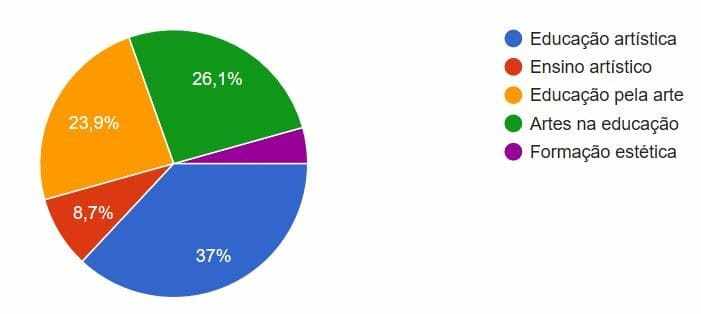
Supremacy belongs to Artistic Education (37%); adding it to Arts in Education, we obtained 63.1%. It is the legislative history of the Portuguese to prevail, leaving the effort of teachers and a circumspect opening to Education for Art (23.9%). The results obtained in Artistic Education (8.7) and Aesthetic Formation (4.3%) prove the lag with the current situation. Artistic Education and Arts in Education (63.1%) are ministerial impositions that still dominate in the arts of teaching in general. Art Education (23.9%) signs of walking towards self-education.
We add the Second World Conference on Artistic Education, welcomed in 2010 by the Government of the Republic of Korea, forming an alliance between NGOs (Non-Governmental Organizations) – the International Society for Education through Art, the International Society for Music Education and the International Drama/Theatre and Education Association – which created a strong coalition for the protection of Artistic Education and the writing of a roadmap for it, where educational policies are structured. It is an important document in the defense of Education by Art/Artistic Education where the fundamental strategy for the successful application of this concept in the educational field is outlined (CASALS, 2012).
Table 2. Objectives of the educational process in arts
| Goals | I completely agree | Agree | Total |
| Consolidate movement and experience | 20 | 19 | 39 (85%) |
| Interpreting freedom and non-directivity | 23 | 15 | 38 (83%) |
| Apply teamwork | 26 | 14 | 40 (87%) |
| Developing self-education | 22 | 17 | 39 (85%) |
| Translating globalisation and inclusion | 27 | 13 | 40 (87%) |
Graph 2

The parameters apply teamwork and translate globalization and inclusion (87%) interconnect with current affairs and the future. Inclusion is all economic, social, health, and teamwork is valued at a time when new technologies individualize personality. If we evaluate the parameters consolidate movement and experience and develop self-education, similar values (85%). The objectives of the educational process in the arts are appropriate to the actuality of teaching, at least in pedagogically correct answers…
4.1.2 INTERDISCIPLINARITY IN ARTS
Table 3. Contributions to the promotion of the Arts
| Activities | I completely agree | Agree | Total |
| Musical Expression | 35 | 09 | 44 (95,6%) |
| Dramatic Expression | 33 | 12 | 45 (97,8%) |
| Plastic Expression | 33 | 09 | 42 (91,3%) |
| Motor Expression | 33 | 12 | 45 (97,8%) |
Graph 3

The unequivocal option is in completely agree ing for the four expressions; however, I completely agree and agree provide us with a similar percentage (97.8%) for Dramatic Expression and Motor Expression, followed by Musical Expression (95.6%) and Plastic Expression (91.3%), a surprising result – although the difference is not substantial – since it is one of the most worked areas in teaching and art therapy.
By the way, we give news of an interdisciplinary project, “The street where I live…”, in the 1st CEB” (GOMES, 2014, p. 46-48), in the Basic School of Sales of Azeitão (Setúbal), which developed in three stages: 1. Portuguese and Mathematics; 2. Plastic Expression deserved enhancement at all stages; 3. Musical Expression was included in the second and third stages; 4. And the Physical-Motor and Dramatic Expressions in the third stage.
The project comes to the meeting of Conceição (2015 apud CURRÍCULO NACIONAL, 2000 apud PEREIRA, 2012) which points to Expressions as essential for the personal, social and cultural development of the child, and should be worked in the same way as the others.
Likewise? The author (and so many others), like us, predict this correct posture, but, as we exposed behind, the terrain is steep and hardly burp! However, one experience here and another to follow… they will leave enough ballast to fill, in node, by educators and teachers.
In the 1st CEB, Plastic Expression and Visual Education; Expression and Music Education; the Dramatic Expression/Theatre; and the Physical-Motor Expression/Dance maintain sproper ness being worked, in an integrated way, by the generalist teacher, under the designation of Artistic Expressions. Theoretically, the interdisciplinary horizontal articulation and the vertical articulation in the PE and in subsequent cycles of Basic Education are guaranteed. But reality has physical and mental barriers that schools and guardianship take to resolve in favor of the more humanistic side, more in line with the values of our era. The public narrative (of guardianship, of trainers, pedagogues, of groupings) and legislative are interconnected, in general, but the reality is different, with generous and honorable exceptions.
If the Learning Goals (DGIDC apud VAZ, 2015) could cooperate in the coordination of specialist teachers from different artistic areas, there are constraints for Artistic Expression/Art; for Piaget (1954 apud BAHIA, 2009 apud VAZ, 2015, p. 26) the biggest obstacle lies in the family and the traditional education system, which limits “[…] the natural spontaneity of artistic expression that children reveal early not betting on symbolic, visual and artistic literacy and creative thinking […]”.
We agree with Piaget[7] on a very simple, educational, propelling task of the child’s autonomy: when a child begins to care, we must question him/her about the meaning of his “drawings”, make notes, give them and form a dossier that helps the PE educator understand his stage of development. It is a way of diluting the gaps in the school-family-society trilogy, because we know that the Portuguese School has extraordinary experiences in all fields, nodibly in arts/expressions. There will be a lack of public impetus and exposure of exceptions for them to be generalised.
Table 4. Discriminate your participation in activities/events – up to a maximum of five – indicating your degree of satisfaction
| Activity | Good | Very good | Subtotal | Reasonable | Total |
| 1 | 15 | 12 | 27 (64,2%) | 06 (14,2%) | 78.4% |
| 2 | 14 | 11 | 25 (59,5%) | 08 (19,0%) | 78,5% |
| 3 | 14 | 09 | 23 (54,7%) | 11 (26,1%) | 80,8% |
| 4 | 15 | 09 | 24 (57,1%) | 08 (19,0%) | 76,1% |
| 5 | 12 | 10 | 22 (52,3%) | 08 (19,0%) | 71,3% |
Graph 4
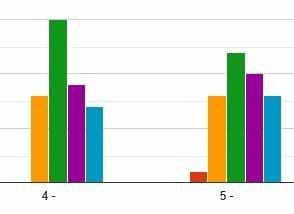
Source: Data obtained from the Google Forms survey
No activities are mentioned in the requested proposals. In the good and very good dimensions, activity 1 stands out (64.2%), followed by the others with a maximum difference of 11.9%. Bad (6.5%) appears only in activities 1 and 5. If we add the Reasonable dimension, activity 3 comes first, followed by activities 2 and 1, with a small difference. The activities promoted in class and extracurricular contexts point to a positive scenario, both at the level of teachers (47.8%), and at the level of students and student workers (41.3%) and another option (10.9%) (compare with table-graph 15).
There is a lot of commitment to await from teachers who irreversibly realize that we find ourselves at a time when the classroom is a fundamental part of learning, but never a shell, because the instruments are immeasurably more valuable: the outside and technologies, namely the social networks where the mobile phone fits, with abstinence adjustable according to the rules established in the classroom.
In the curriculum plan of the 1st CEB (VAZ, 2015), artistic expressions are launched to a lower area due to the allocation of minimum times for Portuguese and Mathematics and the inpreparation of teachers themselves to teach them, but it is recommended that Artistic Education have an important place in curricula and school schedules, being reinforced in situations of difficulties in learning or school integration , an exhortation that is difficult to achieve by the family and social pressure squeewhich require swift results.
4.1.3 ART THERAPY
Table 5. It is the psychotherapeutic treatment that uses as mediation
| Expressions | Yes | No | Maybe |
| Music therapy | 33 (75,0%) | 03 (06,8%) | 08 (18,1%) |
| Dramatherapy | 26 (59,1%) | 10 (22,7%) | 08 (18,1%) |
| Dance therapy | 27 (61,3%) | 06 (13,6%) | 11 (25,0%) |
| Plastic Expression | 30 (65,2%) | 07 (15,2%) | 09 (19,5%) |
Graph 5

Respondents opted for Music Therapy (75%) and plastic expression (65.2%), leaving dance therapy (61.3%) and Dramatherapy (59.1%). This means that schools should bet more on Music Therapy even though Plastic Expression is the most recurrent. Regarding the non-option, Dramatherapy (22.7%) and Plastic Expression (15.2%) are the most chosen. In the option perhaps, the highlight of Dance therapy (25%) is visible; Music therapy and Dramatherapy have the same percentage (18.1%), that is, respondents reveal doubts in its use, as well as in Plastic Expression (19.5%) – surprising as we realized above.
It is worth resorting to Freud who did not use art as part of the psychotherapeutic process (REIS, 2016). Art therapy was discovered in the work of the English painter Adrian Hill (Art vs Ilness, 1945), who used internment time to paint: doctors noticed a faster recovery than other patients. Jacobson (1974, p. 41 apud ROCHA, 2010, p. 18) states that: “[…] there are reasons to want a prudent application of these principles in clinics and schools to reduce the wear and tear of the human organism and increase human efficacy”.
For Music Therapy, a study with autistic children in the Grouping of Schools of S. Gonçalo B2, B3 (Torres Vedras), conducted by Monteiro (2017), values its application. The music therapist, in a school context, is part of a multidisciplinary team: speech therapist, physiotherapist, special education teacher, among others. Teamwork favors the final results (CUNHA, 2008 apud MONTEIRO, 2017): music is fundamental for the user to manifest emotions, dreams, fantasies, physical experiences and memories. There are methods to introduce the songs in a process of music therapy (Lucas, 2012): a) reproduction/performance of songs, as a way to experience the emotions expressed by them; b) composition of group songs; c) sharing a recorded song that expresses something that the patient wants to communicate about himself; d) analysis of the lyrics of a song, relating it to the lives of patients; e) creation of a new letter for a song chosen by the group through the technique of spaces – technique in which the therapist writes part of the sentences and the patients complete.
As for Dramatherapy, the “fantasy games” and “make-believe” – improperly called dramatic play or dramatic expression – will have their origin in the playful activity of the child and not in the Greek theater, as some authors believe (AVELINO and BENTO, 1989 apud SOUSA, 2003, II, p. 22).
In dramatic expression, the child practices life, is making very important emotional interior structures work, develops at the level of the domain of the connection of the phenomena imagination/action. The dramatic expression is not theater, that part of a text and that is a barrier for the child. In dramatic expression, the child practices life, is making very important emotional interior structures work, develops at the level of the domain of the connection of the phenomena imagination/action.
In Dance therapy, the goal is how we feel inwardly as opposed to how we show ourselves outwardly (CERRUTO, s.d.). In 2003, Sousa mentions the programmatic organization of the educational dance sessions of an Art therapy plan for age groups from 3 to 10 years.
In Plastic Expression, the knowledge of the experiences described by Oliveira & Santos (2004) – Art/Expression; Interaction/Art therapy; and Creativity – lead the childhood educator to use the Plastic Expression in a more conscious, intentional and systematic way, corresponding to the OCEPE and their ability to freedom to work with children. We do not fully agree, because the mention of OCEPE is, in itself, an attitude of attachment to the official, while curricular flexibility (currently in implementation) allows freedom of work with children.
Table 6. Evaluate the appropriate intervention strands for Art Therapy
| Area of intervention | Important | Very important | Total |
| Health | 21 | 23 | 44 (95,6%) |
| Psychology | 15 | 28 | 43 (93,4%) |
| Social | 16 | 29 | 45 (97,8%) |
| Educational | 19 | 27 | 46 (100,0%) |
| Cultural | 18 | 25 | 43 (93,4%) |
| Artistic | 19 | 22 | 41 (89,1%) |
| Occupational | 24 | 15 | 39 (84,7%) |
Graph 6

The option focuses on the educational aspect (100%), followed by the social aspect (97.8%), health (95.6%), psychology and culture (93.4%); the areas selected last, are artistic (89.1%) and occupational (84.7%); the percentage space is only 5.3%.
Art therapy finds different applications in health-based evaluation, prevention, treatment and rehabilitation; the field of activity has expanded, but insufficiently. The “development of Art therapy as a specific area of work took place in Psychology” (REIS, 2016, p. 144). At present, the most important thing is to enlarge it. With adequate training and recourse to specialists? Of course, because this is the only way educators and teachers will be able to feed an area as necessary as those that are part of the OCEPE and the Curriculum Plan of the 1st BEC .
Table 7. Art therapy is a familiar concept in PE and 1st CEB schools
| Attitude | In PE education | In the teaching of the 1st Cycle | Total |
| I completely disagree | 05 (10.8%) | 04 (0.88%) | 09 (11.6%) |
| Disagree | 12 (26.0%) | 12 (26.6%) | 24 (52.6%) |
| I don’t agree or disagree | 08 (17.3%) | 11 (24.4%) | 19 (41.7%) |
| Agree | 07 (15.2%) | 07 (15.5%) | 14 (30.7%) |
| I completely agree | 10 (21.7%) | 06 (13.3%) | 16 (35.0%) |
| NS/NR | 04 (0.86%) | 05 (11.1%) | 09 (11.9%) |
Graph 7.a
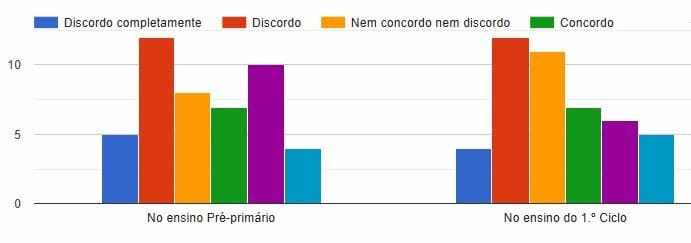
Graph 7.b
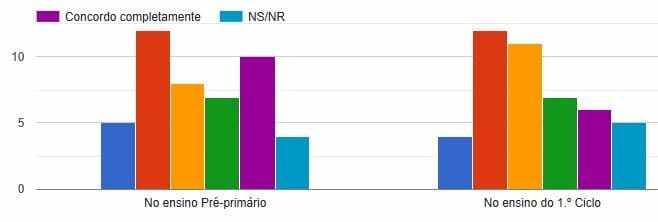
Source: Data obtained from the Google Forms survey
In the PE, I completely agree and agree to get 36.9%; if we add do not agree or disagree (17.3%), the three dimensions are 54.2%. In general, I completely agree and agree to 65.7% while I completely disagree and disagree reach 64.2%, sharing, practically, as in the individual analysis. It is a dimension to work broadly at these two levels of education; experiences are not yet as broad as one would require, and training does not allow educators, teachers, parents and guardians to value it adequately.
Table 8. Knowledge of art therapy projects in a school context
| Yes | 11 | 23,9% |
| No | 23 | 50,0% |
| Maybe | 12 | 26,1% |
Graph 8
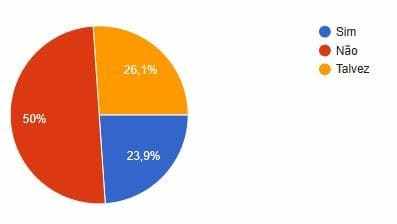
Half of the respondents are unaware of art therapy projects in teaching units and 26.1% are not sure they are aware of this subject. Only 23.9% claim to know this type of activities. In 2018, the Portuguese Society of Art Therapy (SPAT) (http://arte-terapia.com/wp-content/uploads/2013/09/Revista-Arte-Viva-8-2018.pdf) counted eight educational establishments using this practice. A start, we affirm, but it is a record that leads us to the belief of broad results in the near future.
Table 9. Knowledge of Art therapy projects outside the school context
| Yes | 23 | 50,0% |
| No | 15 | 32,6% |
| Maybe | 08 | 17,4% |
Graph 9
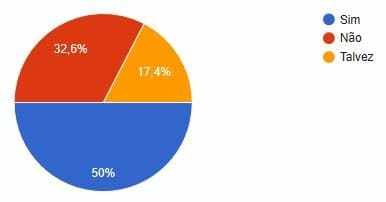
Outside the school context, half of the respondents are aware of projects in Art Therapy. Those who indicate the answers do not and perhaps have to do with the fact that there is not enough information about the projects or simply that it is not an area that asks them to pay attention.
5. THE ARTS WITH HOSPITALIZED CHILDREN
Table 10. Arts with hospitalized children: music, drawing, painting, dance, singing and sport arouse distinct interests in children
| Level 03 | 01 (02,2%) |
| Level 04 | 13 (28,3%) |
| Level 05 | 32 (69,9%) |
Graph 10

The majority of respondents (69.6%) answered at level 5, that is, considering that all areas arouse different interests in children; about 28.3% responded at level 4 and 2.2% were at the 3rd level.
Esteves (2013) ensures that the reality of the child’s hospitalization process is always peculiar, because one must take into account his pathology, treatment, pre- and post-surgery. The realization of playful activities makes children less idle and anxious through occupations already present in their daily lives before hospitalization. The work with arts aims to develop an integrated service among all professionals, respecting multidisciplinarity. – Kryminice and Cunha (2009, p. 179-180 apud ESTEVES, 2013).
Studying is part of hospitalization, but its function is to mediate the external world with the present reality of the child (PORTO, 2008 apud ESTEVES, 2013). We have positive and consistent positions on the subject, which we support, because the recovery of a hospitalized child is all the greater than the playful and emotional stimuli it absorbs. The advances are tenuous, knowing that we are faced with a question of inclusion by the right to education for hospitalized children, and are still on the margins of public policies aimed at the need to regularize this care. There is a need to promote nomenclatures such as hospital class, school hospitalization, hospital pedagogy, hospital school, among others, for standardization, at the national level, and legislative clarification of the central power (SALDANHA and SIMÕES, 2013).
Table 11. School performance improves with artistic activities
| Level 02 | (01) (2,2%) |
| Level 03 | 04 (08,7%) |
| Level 04 | 12 (26,1%) |
| Level 05 | 29 (63,0%) |
Graph 11

I completely agree (5) and agree (4) total 89.1%. Artistic activities not only contribute to the child’s development, but also increase their self-esteem and reasoning skills; these agents contribute to improvements in other matters in the interdisciplinarity competition. Thus, Eisner (apud CATTERALL, 2012) states that there are too many works that are sustained, with a lot of active interest in the possible relationships between the involvement of the arts in teaching and the development of skills that contribute to school success.
The place of art in school is configured from a pre-established curriculum, which is redesigned, discussed, reelaborated, while lived. Power relations imply expansion, enlargement and flexibility of this rigid curriculum. The single power legitimized by the prescribed curriculum “[…] is a step to allocate democracy in a mobile platform, at risk […]” (OLIVEIRA, 2012 apud FILHO; BULCÃO; BATISTA, 2019, p. 13).
Table 12. Artistic activities are a practice to be adopted in all hospital units aimed at children
| Level 02 | 01 (02,2%) |
| Level 03 | 01 (02,2%) |
| Level 04 | 16 (34,8%) |
| Level 05 | 28 (60,9%) |
Graph 12
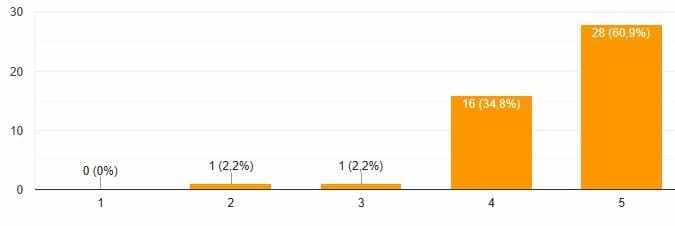
The majority (60.9%) I totally agree (5) assumes that artistic activities are a practice to adopt in all hospital units aimed at children, followed by 34.8% who say they agree (4), being only contradicted by 2.2%, who deny this need. Without opinion, they declared themselves 2.2%. Lack of information to identify the option of 4.4% – null or disagreement.
Cruz (2012) indicates that hospitals can be stimulating environments for children with therapeutic activities that allow experiences identical to those they would have in their normal environment. Valladares (2003, p. 66 apud CRUZ, 2012) alludes to the role of expression by art: it enables children to escape from unpleasantness, pain and anxiety, monotony and intense emotion.
Not being a generalized practice (absence of open mentalities of hospital administrations, constraints of facilities, difficulties of voluntary support of specialists, among others), there are practices that are being exposed and expanded, although not exponentially.
6. THE ROLE OF THE ARTS IN THE DEVELOPMENT OF CHILDREN WITH SPECIAL NEEDS
Table 13. ASD (Autism Spectrum Disorder)
| Arts | a) I do not agree or disagree | b) I agree | c) I completely agree | Total
(b) and c) |
| Arts and expressions promote the development of the child. | 03 (6.5%) | 13 (28.2%) | 30 (65.2%) | 93.4% |
| The plastic expression allows the involvement of the child’s senses, especially touch and vision. | 04 (8.6%) | 10 (21.7%) | 32 (69.5%) | 91.2% |
| The visual arts influence the performance, involvement and imagination of the child with ASD. | 04 (8.6%) | 15 (32.6%) | 27 (58.6%) | 91.2% |
Graph 13.a
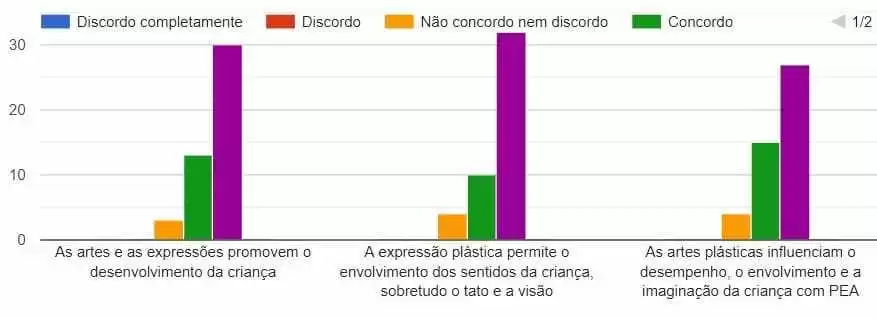
Graph 13.b
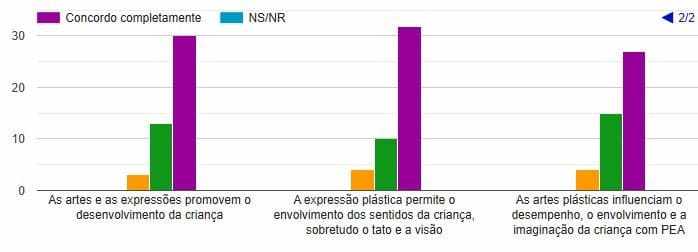
Source: Data obtained from the Google Forms survey
In addition, I agree and agree completely, the proximity of the three dimensions is notorious, evidencing itself slightly above The arts and expressions promote the development of the child (93.4%), deducing that the respondents are at a high level of understanding in relation to the issues considered; that is, the arts have a preponderant role in the development of children with special needs.
By becoming able to express their own voice, students will be able to engage in culture, finding a fairer place in society – MacLean certifies (2008 apud VAZ, 2015). The tutelary effort, at the legislative level, has been high, not corresponding, in practice, to the desirable, because it is not accompanied by the availability of teaching staff, among others.
7. RESPONDENT PROFILE
Table 14. Age
| Up to 20 years | 04 | 08,7 % |
| 21-25 years old | 11 | 23,9% |
| 26-30 years | 03 | 06,5% |
| 31-35 years old | 04 | 08,7% |
| 36-40 years | 05 | 10,9% |
| 41-45 years old | 09 | 19,6% |
| + 45 years old | 10 | 21,7% |
Graph 14
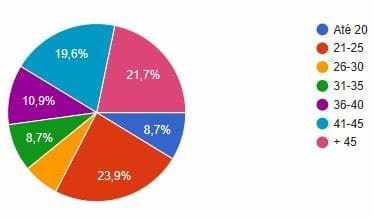
Age group 21-25 years (23.9%) dominant (11 respondents), as you would expect; a) if we add three groups – “up to 20” – (8.7%), “21-25” (23.9%) and “26-30” (6.5%) – we reached 39% (18 respondents); b) uniting “31-35” (8.7%) with “36-40” (10.9%) reached 19.6% (9 respondents); c) adding “41-45” (19.6%) with “+ 45” (21.7%), we obtained 41.3% (19 respondents), a result that comes from teachers who attended specializations in ESE. Younger age groups (39%) and fewer young people (41.3%) approach percentage.
Table 15. Professional activity
| Student | 13 | 28,3% |
| Worker-student | 06 | 13,0% |
| Educator | 06 | 13,0% |
| Teacher 1st Cycle (+ unemployed) | 08 | 17,4% |
| Teacher 2nd Cycle | 01 | 02,2% |
| Professor IESF (+ collaborator IESF) | 08 | 17,4% |
| Another option | 04 | 08,7% |
Graph 15
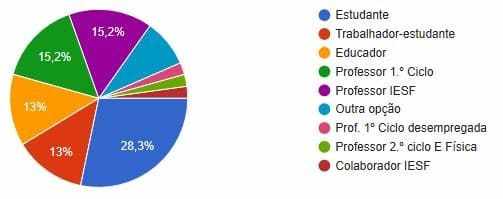
In descending order: student – 28.3%; IESF professor – 17.4%; professor 1st BEC- 17.4%; childhood educator – 13%; student worker – 13%; another option – 8.7%; teacher 2nd Cycle – 2.2%. The largest in the world (30.4%) focuses on the 1st BEC teacher and educator set; the “Other option” has been registered for situations of non-employment in education.
Table 16. Genre
| Male | 12 (26,1%) |
| Female | 34 (73,9%) |
Graph 16
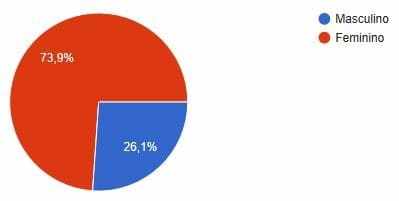
Female dominance (34 – 73.9%) not surprising in teaching in general and in our universe of respondents, particularly; males are almost one third (12 – 26.1%).
Table 17. Educational qualifications
| No degree | 15 | 32,6% |
| Degree | 12 | 26,1% |
| Masters | 13 | 28,3% |
| Phd | 08 | 13,0% |
Graph 17
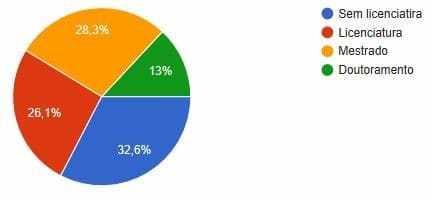
The students corresponded in a higher percentage (32.6%) followed by masters (28.3%) and by graduates (26.1%); finally, doctorates (13%). The order is coherent, however,
the percentage of respondents could have been higher given the size that has the potential to change the course of Education.
Table 18. County where he carries out his professional activity
| Fafe | 14 (42,4%) |
| Paredes | 06 (18,1%) |
| Guimarães | 05 (15,1%) |
| Santa Maria da Feira | 03 (09,0%) |
| Braga | 01 (03,0%) |
| Vila Verde | 01 (03,0%) |
| Porto Santo | 01 (0,03%) |
| Unemployed | 01 (03,0%) |
| Invalid (GCI)[5] | 01 (03,0%) |
Graph 18
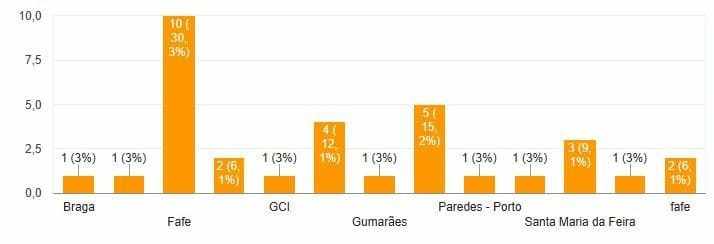
Fafe naturally records the highest percentage (42.4% – Fafe; GCI; bar above S.ta Maria da Feira; and Fafe), left over for Paredes-Porto (18.1%), S.ta Maria da Feira (9.1%), Vila Verde (3%) and Porto Santo (3%) the rest, coming from students of specializations, with great probability – totaling 33.2%, proof that the ESE has an offer of appreciable quality.
8. CONCLUSIONS
Aligning the results of the survey, we fixed the dominance of the perception of Artistic Education (37%); adding it to Arts in Education we obtained 63.1%. The effort scans of teachers and an expanded opening to Art Education (23.9%) – a path for self-education – remains. It is at the UN, in 2010, that education for art and artistic education is defended (CASALS, 2012, p. 28-29).
In the objectives of the educational process in arts, the dimensions consolidate movement and experience and develop self-education have similar values and are completed in the order of 85%; objectives are appropriate to the timeliness of teaching.
In interdisciplinarity and its contributions to the promotion of the arts, Plastic Expression (91.3%) – below dramatic expression (97.8%) and Musical Expression (95.6%) – admires for being one of the most worked areas in teaching and art therapy.
Art therapy as a psychotherapeutic treatment has the option of Music Therapy (75%) and Plastic Expression (65.2%). In areas of intervention appropriate to Art therapy, the undeniable option focuses on the educational aspect (100%). Art therapy as a familiar concept is revealed in Preschool schools and a little more than 50% in the 1st CEB. Half of the respondents do not know Art Therapy Projects in teaching units and 26.1% are not sure of their knowledge on this subject. Outside the school context, half of the respondents are aware of projects in Art Therapy. This is one of the dimensions that there is much to look forward to in terms of quality and promotion of self-education.
On the arts with hospitalized children, music, drawing, painting, dance, singing and sport, the majority of respondents (69.6%) considers that all areas arouse distinct interests in children. It is the full assumption of difference in every child.
The appreciation attributed to artistic activities in school performance reaches 89.1%, contributing to the child’s development and increasing their self-esteem and reasoning capacity; these actors contribute to improvements in other interdisciplinary matters; totally agrees that artistic activities are a practice to be adopted in all hospital units reaching 60.9%, probably lacking more solid information about their benefits.
The role of arts and expressions in the development of children with special needs, namely ASD (Autism Spectrum Disorder) is capital for (93.4%).
The profile of the majority respondent is in the age group of 21-25 years (23.9%); if we join three groups – up to 20 – (8.7%), 21-25 (23.9%) and 26-30 (6.5%) we reached 39%; adding 41-45 (19.6%) with more than 45 (21.7%) we earned 41.3%, a result that comes from teachers who attended specializations in ESE.
Students, in academic qualifications, correspond to 32.6%, closely followed by masters (28.3%); then graduates (26.1%) and doctorates (13%).
As for professional activity, Fafe registers 42.4%, climbing to Paredes-Porto 18.1%, S. ta Maria da Feira (9.1%), Vila Verde (3%) and Porto Santo (3%), revealing the formative quality of the HSE.
9. FINAL CONSIDERATIONS
Herbert Read was the capital for the movements that advocated Education for Art in Portugal; however, we resort to studies that deal with Education by Art, but without including that author in the bibliographic references. This may mean the acquisition of autonomy by pedagogues who, exercising projects, have reached enriching conclusions for Education by Art.
The objectives outlined are echoed in the results: a) to associate Education by Art with the promotion of self-education (graph tables 1, 3, 5, 10, 11; b) to evaluate the promotion of arts in teaching, including interdisciplinarity and events (graph tables 1, 2, 3, 4, 14); c) to justify the dimension of Art therapy in school and non-school contexts (graph tables 5, 6, 7, 8; d) understand school performance with performance in artistic activities in non-school context and in children with special needs (graph tables 9, 10, 11, 12, 13).
The Expressions/Arts trigger their motivational interests in the child, becoming aware of themselves as authors and image builders (HOHMANN and WEIKART, 1997 apud CANELAS, 2015). Impulses, sensations and feelings need free expression. Artistic experiences provide cognitive, affective, expressive possibilities – such as creation, reflection and understanding that favor the construction of personal and social identity (FRÓIS et al., 2000 apud CANELAS, 2015).
In the results, artistic education predominates, leaving teachers an opening for Education for Art. Half of the respondents do not know art therapy projects in teaching units; outside the school context, there are manifestations of knowledge of projects in Art therapy. About the arts with hospitalized children, Music, Drawing, Painting, Dance, Singing and Sport, most consider that all areas arouse distinct interests in children. The role of arts and expressions in the development of children with special needs is expressive.
About the starting question – What is the role of Art Education for the evolution of the Preschool and the 1st CEB? – the results are encouraging, but, not reaching the legislative impositions, the work to be done to promote Education by Art will have to be carried out on the basis: educators, teachers, sociocultural agents and other community. We need to take advantage of the emulation of the numerous examples of Preschool and 1st CEB to support a reality we want next, taking advantage of the investments of researchers and results that are on the ground.
It is basic that Education by Art achieves a dignified status as a corollary of a humanist commitment, constituting an instrument for self-education, a study that we will deepen later. The artistic dimensions will be more visible with a basic positional reinforcement through a solid interdisciplinary collaboration in the Arts/Expressions in order to reach the level of Education for Art, moment, among others, in which the child will feel the benefits of self-education. We will soon go back to some of the dimensions discussed here.
REFERENCES
BAHIA, Sara. Considerações sobre a educação para a arte e para a cultura, ou como levar Clio à escola. Revista Lusófona de Educação, Universidade de Lisboa, n.º 16, p. 47-58, 2010. Disponível em: <https://repositorio.ul.pt/bitstream/10451/2755/1/Clio-RevistaLusofona%2C2010.pdf>. Acesso em: 05 jan. 2020.
BARATA, Vanessa Miguel Xavier. 2014. 203f. Eu sou arte. O lugar das expressões no desenvolvimento de crianças com NEE. Um estudo de caso com crianças com PEA. Dissertação (Mestrado em Educação Especial – Domínio Cognitivo e Motor) – ESE do Instituto Politécnico de Castelo Branco, 2014. Disponível em: <https://repositorio.ipcb.pt/handle/10400.11/2497> Acesso em: Acesso em: 05 jan. 2020.
CÂMARA, Maria Margarita Gomes. Contributos da experiência da Educação pela Arte (1971-1982). Para a Educação Artística em Portugal. 2008. 57f. Dissertação (Mestrado em Educação Artística) – Faculdade de Ciências Sociais e Humanas, Universidade do Algarve, Faro, 2007. Disponível em: <http://hdl.handle.net/10400.1/455> Acesso em: 12 abr 2020.
CARREIRA, Joana Filipa Formiga. 2013. 88f. A Arte: uma viagem mágica com Miró. Dissertação (Mestrado em Ciências da Educação – Educação pela Arte) – ESE João de Deus, Lisboa, 2013. Disponível em: <https://comum.rcaap.pt/bitstream/10400.26/5083/1/A%20Arte%2c%20uma%20viagem%20m%c3%a1gica%20com%20Mir%c3%b3.pdf> Acesso em: 10 jun 2020.
CARVALHO, Ruy. A estética da epistemologia: Metodologia da fundamentação em arteterapia/psicoterapia. Revista Portuguesa de Arteterapia. Arte Viva, Lisboa, n.º 8, p. 66-134, out. 2018. Disponível em: <http://arte-terapia.com/wp-content/uploads/2013/09/Revista-Arte-Viva-8-2018.pdf>. Acesso em: 10 jun 2020.
CASALS, Diana Rodrigues. O Chapitô Criação e Criador da Educação pela Arte em Portugal. 2020. 35f. Dissertação de mestrado – Faculdade de Ciências Sociais e Humanas, Universidade Nova de Lisboa, 2012. Disponível em: <http://hdl.handle.net/10362/7540> Acesso em: 11 maio 2020.
CATTERALL, James S. A experiência artística melhora o desempenho escolar? Resposta a Eisner, 2012.03.12. Disponível em: <http://artenaescola.org.br/sala-de-leitura/artigos/artigo.php?id=69342>. Acesso em: 15 out. 2019.
CERRUTO, E. Dançaterapia. A dança para todos. Centro de Formação Internacional em Dançaterapia – DMT (s.d.). Disponível em: <http://dancaterapia- dmt.com.br/artigos/Dan%E7aterapia!!!%20%20A%20dan%E7a%20para%20todos.pdf>. Acesso em: 15 out. 2019.
CONCEIÇÃO, Raquel Sofia Guerreiro da. A Arte na Educação Infantil. A importância para o Desenvolvimento Infantil. 2015. 55f. Dissertação (Mestrado de qualificação para a docência em Educação pré-escolar) -Instituto Superior de Educação e Ciências, Lisboa, 2015. Disponível em: <https://comum.rcaap.pt/bitstream/10400.26/21565/1/Relat%C3%B3rio%20final.pdf> Acesso em: 20 set. 2019.
CRUZ, Maria Inês Santos Silva. A expressão pela arte no bem-estar da criança em internamento prolongado. 2012. 76f. Dissertação (Mestrado em Ciências da Educação Educação pela Arte) – ESE de João de Deus, Lisboa, 2012. Diusponível em: <https://comum.rcaap.pt/handle/10400.26/3827> Acesso em: 15 jan. 2020.
EÇA, Teresa Torres Pereira de. Educação através da arte para um futuro sustentável. Cad. CEDES, Campinas, vol. 30, n.º 80, p. 13-25, jan.-abr. 2010. Disponível em: <https://doi.org/10.1590/S0101-32622010000100002>. Acesso em: 10 set. 2019.
EÇA, Teresa Torres de. Del arte por el arte a las artes comprometidas con las comunidades: paradigmas actuales entre educación y artes. Pensam palabra, Bogotá, obra n.º 6, p. 16-23, jun, 2016. Disponível em: <http://www.scielo.org.co/pdf/ppo/n16/n16a03.pdf>. Acesso em: 05 out. 2019.
EDUCAÇÃO PARA RECORDAR. 27 abr 2011. Calvet de Magalhães. Memórias de um mestre. Disponível em: <https://largodoscorreios.wordpress.com/2012/11/05/calvet-de-magalhaes-4/>. Acesso em: 15 out. 2019.
EDUCAMAIS. Quem é o dramaterapeuta? (s.d.). Disponível em: <http://educamais.com/quem-e-o-dramaterapeuta/>. Acesso em: 23 out. 2019.
ESTEVES, C. R. Pedagogia hospitalar: um breve histórico, 2013. Disponível em: <https://pedagogiaaopedaletra.com/wp-content/uploads/2013/06/HISTÓRICO-DA-PEDAGOGIA-HOSPITALAR.pdf>. Acesso em: 10 out. 2019.
FILHO, Aldo Victorio, BULCÃO, Heloisa Lyra, BATISTA, Leonardo Moraes. O Espaço na/da Arte e na/da Educação como (Re)Existência. Educação e Realidade, Porto Alegre, vol. 44, n.º 3, e84913, 15 p. 2019. Disponível em: <http://dx.doi.org/10.1590/2175-623684913>. Acesso em: 02 nov. 2019.
FREITAS, Henrique.; JANISSEK-MUNIZ, Raquel; MOSCAROLA, J. Modelo de formulário interativo para análise de dados qualitativos. Revista de Economia e Administração, Brasil, S. Paulo-SP, v. 4, nº 1, p. 27-48, janeiro/março, 2019. Disponível em: <https://adrodomus.blogspot.com/2008/06/mtodo-quantitativo-versus-mtodo.html>. Acesso em: 04 jan. 2019.
GOMES, Carla Sofia Martins. A rua onde eu moro…. Um projeto interdisciplinar no 1º Ciclo do Ensino Básico. 2020. 80f. Dissertação (Mestrado em Educação Pré-Escolar e Ensino do 1º Ciclo do Ensino Básico), ESE de Setúbal, 2014. Disponível em: < https://comum.rcaap.pt/bitstream/10400.26/7791/1/Projeto%20de%20Investigação_Carla%20Gomes_120140002_VersãoDefinitiva.pdf> Acesso em: 03 mar 2020.
KEEL, J. Herbert Read on Education through Art. Journal of Aesthetic Education, 3 (4), 47-58, 1969. Doi:10.2307/3331429. Disponível em: <https://www.jstor.org/stable/3331429?seq=1#metadata_info_tab_contents>. Acesso em: 10 jun. 2020
LUCAS, Paula Cristina da Costa . Encontros sonoros: musicoterapia com crianças e jovens em acolhimento institucional. 2012. 73f. Dissertação (Mestrado em Musicoterapia) – Instituto de Psicologia e Ciências da Educação, Faculdade de Ciências, Universidade Lusíada de Lisboa. Disponível em: <http://hdl.handle.net/11067/358> Acesso em: 12 out. 2019.
MATEUS, Raquel; DAMIÃO, Maria Helena; FESTAS, Maria Isabel; MARQUES, Elisa. Educação estética e artística no currículo português do 1.º ciclo do ensino básico: uma via de concretização. Coimbra: Imprensa da Universidade de Coimbra, 2017, p. 229-242. Disponível em: <http://hdl.handle.net/10316.2/41800>. Acesso em: 04 fev. 2020.
MEIRA, Carla Maria Moreira Candeias. 2015. 72f. A Escola Superior de Educação pela Arte e o contributo do Dr. Arquimedes da Silva Santos. Dissertação (Mestrado em Educação Artística), Faculdade de Belas-Artes, Universidade de Lisboa, 2015. Disponível em: <https://repositorio.ul.pt/bitstream/10451/23564/2/ULFBA_TES_865.pdf >. Acesso em: 02 mar 2020.
MONTEIRO, Raquel Sofia Carvalho. 2016. 35f. A musicoterapia em contexto escolar: perturbações do comportamento, espectro do autismo e multideficiência. Dissertação (Mestrado em M u s i c o t e r a p i a) – FCHS, Universidade Lusíada de Lisboa, 2017. Disponível em: <http://repositorio.ulusiada.pt/bitstream/11067/2920/4/mmt_raquel_monteiro_dissertacao.pdf> Acesso em: 02 mar 2020.
MOVEA (Movimento Português de Intervenção Artística e Educação pela Arte). Atividades em movimento. Disponível em: <https://movea.pt/>. Acesso em: 12 out. 2019.
PLANO NACIONAL DAS ARTES. Uma estratégia um manifesto (2019-2024). Disponível em: <https://www.portugal.gov.pt/download-ficheiros/ficheiro.aspx?v=00a06c3f-f066-4036-adc2-b030b946e6ba>. Acesso em: 20 jun. 2020.
REIS, Alice Casanova dos. Arteterapia: a arte como instrumento no trabalho do psicólogo. Psicologia: ciência e profissão, Brasília, vol. 34, n. º1, p.142-157, jan-março, 2014. Disponível em: <http://dx.doi.org/10.1590/S1414-98932014000100011>. Acesso em: 15 jun. 2019.
RIBEIRO, Mónica Sofia Medina. 2019. 93f. Ateliê de arte com crianças de risco. Mestrado (Ciências de Educação Especialidade Em Educação pela Arte) – ESE de João de Deus, Lisboa, 2012. Disponível em: < https://comum.rcaap.pt/bitstream/10400.26/4093/1/MonicaRibeiro.pdf>. Acesso em: 02 dez. 2019.
ROCHA, Manuela José Pinela da. Arteterapia no Ensino Básico. 2010. 30f. Dissertação (Mestrado em Ensino da Educação Visual e Tecnológica no Ensino Básico) – ESE do Instituto Politécnico de Bragança, 2010. Disponível em: < https://bibliotecadigital.ipb.pt/bitstream/10198/3315/1/Relat%c3%b3rio%20Final.pdf> Acesso em: 05 jan. 2020.
SALDANHA, Gilda Maria Maia Martins; SIMÕES, Reguna Regina Rovigati. Educação escolar hospitalar: o que mostram as pesquisas? Rev. Bras. Ed. Esp., Marília, v. 19, n.º 3, p. 447-464, jul-set. 2013. Disponível em: <https://www.academicoo.com/educacao-escolar-hospitalar-o-que-mostram-as-pesquisas/.> Acesso em: 20 nov. 2019.
SANTOS, Maria Emília Brederode, MAGALHÃES, Calvet de. Movimento da Educação pela Arte. In Jornal de Letras, 12.10.2013. Disponível em: <https://inquietacoespedagogicasii.blogspot.com/2013/12/publicado-no-jl-de-dezembro-calvet-de.html>. Acesso em: 04 jan. 2020.
SOUSA, Alberto B. Educação pela arte e artes na educação. Bases psicopedagógicas. Lisboa: Instituto Piaget, 2003, vol.1.
SOUSA, Alberto B. Educação pela arte e artes na educação. Drama e dança. Lisboa, Instituto Piaget, 2003, vol. 2.
SOUSA, Alberto B. Educação pela arte e artes na educação. Música e artes plásticas. Lisboa, Instituto Piaget, 2003, vol. 3.
VAZ, Márcia Andreia de Oliveira. 2015. 69f. Expressões Artísticas e Educação Inclusiva: Práticas Educativas dos Docentes do 1.º Ciclo do Ensino Básico. Dissertação (Mestrado em Ciências da Educação: Educação Especial – Domínio Cognitivo e Motor) – Universidade Fernando Pessoa, 2015. Disponível em: <https://bdigital.ufp.pt/bitstream/10284/4785/1/Disserta%C3%A7%C3%A3o_de_Mestrado_M%C3%A1rcia_Vaz.pdf >. Acesso em: 04 out. 2019.
APPENDIX – FOOTNOTE REFERENCES
- British poet, anarchist and critic of art and literature, Herbert Read was the first President of the International Association of Education for Art, established in 1954.
- https://largodoscorreios.wordpress.com/2012/11/05/calvet-de-magalhaes-4/.
- The website (https://movea.pt/) highlights Arquimedes da Silva Santos (We have never proposed any strict definition, before accepting a general conception that interrelates vague and vast concepts of education and art from a perspective of those who consider, above all and beyond words, the importance of pedagogical activity by artistic expressions in the development, bio-socio-psychological, of children and adolescents.) and Herbert Read (Art must be the basis of education).
- https://movea.pt/
- https://www.portugal.gov.pt/download-ficheiros/ficheiro.aspx?v=00a06c3f-f066-4036-adc2-b030b946e6ba
- Muse of Greek mythology.
- We still need to resort to the mid-20th century…
[1] PhD and Master’s degree in Art History; graduated in History; bachelor’s degree in 1st Cycle of Basic Education.
[2] Master’s student in PE and 1st CEB.
[3] Pe Master’s Student and 1st CEB.
[4] Pe Master’s Student and 1st CEB.
[5] Pe Master’s Student and 1st CEB.
[6] Pe Master’s Student and 1st CEB.
[7] Pe Master’s Student and 1st CEB.
Sent: July, 2020.
Approved: August, 2020.
